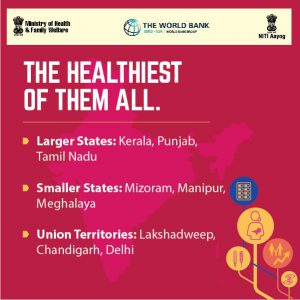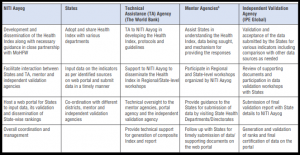
Source: NITI Aayog
Recently, NITI Aayog unveiled the Report on the Ranks of States and Union Territories in the healthcare under the title of Healthy States, Progressive India. Kerala, Punjab and Tamil Nadu are healthiest states under the category of larger states. Though, Mizoram, Manipur and Meghalaya – all are from North East, are dominating the pie in the category of the smaller states. As the policy document claims, the index will serve as an input for providing performance-based incentives and improvement in health outcomes in India. It is anticipated that the health index will assist in the state level monitoring of performance on the health outcome. It requires a careful inquiry on how it evolves, what’s objective, how does the index benefit the states, what is the process flow, who are stakeholders are associated and working in various states and the union territories and what are limitations,
In 2016, NITI Aayog launched the National Index for Performance on Health Outcomes. The initiative envisioned to bring about the much-required improvements in social sector outcomes. As the official communique stated, “It will be used to propel action in the States to improve health outcomes and improve data collection systems. The exercise involves the participation of several partners including technical assistance from the World Bank, mentor agencies to hand-hold States, where required, during the exercise and third-party organizations to validate the data submitted prior to calculation of the index”.
With a partnership with the Ministry of Health and Family Welfare, NITI Aayog spearheaded the initiative where World Bank work as technical assistance agency, institutions like USAID and TERI work as Mentor Agencies and IPE Global works as independent validation agency. The state and union territories are facilitators because the implementation of health schemes is the state subject in India. Since from the beginning, the role and responsibilities were framed. It is enunciated in the following the exhibit.
Objectives of Initiative:
To develop a composite Health Index based on key health outcomes and other health systems and service delivery indicators.
2. To ensure States’ participation and ownership through Health Index data submission on a web-based portal with requested mentor support.
3. To build transparency through independent validation of data by an independent agency.
4. To generate Health Index scores and rankings for different categories of the States and UTs based on year-to-year progress (annual incremental performance) and overall performance.
According to the Reference Guide Book, Indicators are categorized into the domains of Health Outcomes, Governance & Information and Key inputs/processes.
National Index for Performance on Health Outcomes
| Health Outcomes
Sub Domains: |
Governance and Information
Sub Domains: b: Governance
|
Key Inputs/ Processes
|
| a: Key Outcomes: Indicators
|
a: Health monitoring data integrity: Indicators
|
Health Systems/Service Delivery: Indicators |
| Still Birth Rate (SBR) | Data integrity measure: (Institutional deliveries, ANC registered within first trimester) | Proportion of vacant health care provider positions (Regular + Contractual) in public health facilities
|
| Neonatal Mortality Rate (NMR) | Proportion of total staff(Regular + Contractual) for whom an e-pay slip can be generated in the IT enabled Human Resource Management Information System (HRMIS). | |
| Under-ve Mortality Rate (U5MR) | b: Governance: Indicators
|
a: Proportion of specified type of facilities functioning as First Referral Units (FRUs) b. Proportion of functional 24×7 PHCs |
| Maternal Mortality Ratio (MMR) | I: Average occupancy of an officer, combined for the following three posts at State level for last three years – 1. Principal Secretary 2. Mission Director (NHM) 3. Director- Health Services |
b: Proportion of districts with functional Cardiac Care Units (CCU) |
| Total Fertility Rate (TFR) | II: Average occupancy of a full time officer in the last three years for all Districts- District Chief Medical Officers (CMOs) or equivalent post (Heading District Health Services) | Proportion of ANC registered within first trimester against total registrations |
| Proportion of low birth weight among new-borns | Level of registration of births (%) | |
| Sex ratio at birth (number of girls born per 1000 boys born) | Completeness of IDSP reporting of P and L form (%) | |
| Proportion of CHCs with grading above 3 points | ||
| b: Intermediate Outcome: Indicators | Proportion of public health facilities with accreditation certificates by a standard quality assurance programme (NQAS /NABH/ISO/AHPI etc.)
|
|
| Full immunization coverage (%) | Average number of days for transfer of Central NHM fund from State Treasury to implementation agency (Department/Society) based on all tranches of the last financial year
|
|
| Proportion of institutional deliveries | Proportion of National Health Mission (NHM) funds utilized by the end of 3rd quarter | |
| Proportion of pregnant women aged 15-49 years who are anaemic | ||
| Total case notification rate of TB | ||
| Treatment success rate of new smear positive tuberculosis (TB) cases | ||
| Proportion of people living with HIV (PLHIV) on antiretroviral therapy (ART) | ||
| Out of pocket expenditure on drugs and diagnostics in public health facilities (using Pregnant Women as proxy to all patients) |
Source: The Guidebook on Performance on Health Outcomes
Health Index: Salient Features
• The Health Index consists of a limited set of relevant indicators categorized in the domains of Health Outcomes, Governance and Information, and Key Inputs/Processes.
• Health Outcomes are assigned the highest weight, as these remain the focus of the performance.
• Indicators have been selected on the basis of their importance and availability of reliable data at least annually from existing data sources such as the Sample Registration System (SRS), Civil Registration System (CRS) and Health Management Information Systems (HMIS).
• Data on indicators are included for Index calculations after validation by the IVA.
• A composite Index is calculated as a weighted average of various indicators, focused on measuring the state of health in each State and UT for a base year (BY) and a reference year (RY).
• The change in the Index score of each State from the base year to a reference year measures the annual incremental progress of each State.
Key stakeholders: Roles and Responsibilities

5: United States Agency for International Development (USAID), Regional Resource Centre for North Eastern States (RRC-NE), Centre for Innovation in Public Systems (CIPS), The Energy Research Institute (TERI).
Source: Healthy States, Progressive India (Report on the Ranks of States and Union Territories)
Categorization of States and UTs
| Category | Number of States and UTs | Name of States & UTs |
| Larger States | 21 | Andhra Pradesh, Assam, Bihar, Chhattisgarh, Gujarat, Haryana, Himachal Pradesh, Jammu & Kashmir, Jharkhand, Karnataka, Kerala, Madhya Pradesh, Maharashtra, Odisha, Punjab, Rajasthan, Tamil Nadu, Telangana, Uttar Pradesh, Uttarakhand and West Bengal |
| Smaller States | 8 | Arunachal Pradesh, Goa, Manipur, Meghalaya, Mizoram, Nagaland, Sikkim and Tripura |
| Union Territories (UTs) | 7 | Andaman & Nicobar, Chandigarh, Dadra & Nagar Haveli, Daman & Diu, Delhi, Lakshadweep and Puducherry |
Source: Healthy States, Progressive India (Report on the Ranks of States and Union Territories)
The United States Agency for International Development (USAID), Regional Resource Centre for North Eastern States (RRC-NE), Centre for Innovation in Public Systems (CIPS) and The Energy Research Institute (TERI) are playing the role of mentor agencies in various states and UTs. Mentors were assigned to most States to facilitate data collection and submission on the portal. The Empowered Action Group (EAG) States and North-Eastern States were provided dedicated mentor support which other states received on request. The mentor agencies assigned to various States are listed the following exhibit:
List of Mentor Agencies:
| Agency | States |
| United States Agency for International Development (USAID) | Uttar Pradesh, Uttarakhand, Odisha, Chhattisgarh, Punjab, Himachal Pradesh, Bihar, Jharkhand, Rajasthan, Madhya Pradesh, Haryana, Chandigarh, West Bengal |
| Regional Resource Centre for North Eastern States (RRC-NE) | Assam, Meghalaya, Arunachal Pradesh, Mizoram, Manipur, Nagaland, Sikkim, Tripura |
| Centre for Innovation in Public Systems (CIPS) | Andhra Pradesh, Telangana |
| The Energy Research Institute (TERI) | Delhi |
Source: Healthy States, Progressive India (Report on the Ranks of States and Union Territories)
Larger States: Overall performance in reference year – Categorization
| Aspirants | Achievers | Front-runners |
| Haryana | Gujarat | Kerala |
| Jharkhand | Himachal Pradesh | Punjab |
| Uttarakhand | Maharashtra | Tamil Nadu |
| Assam | Jammu & Kashmir | |
| Madhya Pradesh | Andhra Pradesh | |
| Odisha | Karnataka | |
| Bihar | West Bengal | |
| Rajasthan | Telangana | |
| Uttar Pradesh | Chhattisgarh | Source: Healthy States, Progressive India (Report on the Ranks of States and Union Territories) |
Source: Healthy States, Progressive India (Report on the Ranks of States and Union Territories)
Smaller States: Overall performance in reference year – Categorization
| Aspirants | Achievers | Front-runners |
| Tripura | Manipur | Mizoram |
| Nagaland | Meghalaya | |
| Sikkim | ||
| Goa | ||
| Arunachal Pradesh |
Source: Healthy States, Progressive India (Report on the Ranks of States and Union Territories)
Finally, there is need to discuss the limitation of the index. It is documented that some critical areas such as infectious diseases, NCDs, mental health, governance, and financial risk protection could not be fully captured in the Index due to non-availability of acceptable quality of data on an annual basis. For several indicators, the data was limited to service delivery in public facilities due to the paucity and uneven availability of private sector data on health services in the HMIS, as the document mentioned.
Policymakers tried their best to engage a set of stakeholders ranging from the multilateral institutions to independent validation agency. In hindsight, it’s strengthening a new narrative that the era of government knows best and all is over. For example, NITI Aayog availed services of IPE Global as an independent validation agency to review and validate the health index data and the state rankings. Another thing is worthwhile to mention that they publically presented the timeline and the process flow of developing the health Index which involved various steps. Coincidentally, the report came in the backdrop of a new scheme in the healthcare which is known as Ayushman Bharat as the Prime Minister talked about in the Parliament and how it’s going to address the pressing problems in healthcare is largely depends on an efficient implementation at the national level.


















